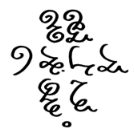Leaderboard
Popular Content
Showing content with the highest reputation on 05/04/2025 in all areas
-
This work is impressive and considerable. I think that for its length it has no comments. Nowadays it is difficult to hook people with extensive works. Greetings.2 points
-
Unable to sleep once again, this early morning I have managed to compose a Late Romantic-style overture for string orchestra. This piece's overall character stems from the metaphor of a harsh storm passing, as hinted by the German title shown in the score: Der abflauende Sturm. Albeit short, compared to my usual standards it is both quite emotional and reflective simultaneously as I tried to pour my feelings on the current state of affairs in my life into music, and I must say, in terms of either harmonic variety and dynamic expression, I think it turned out better than I could have ever imagined, especially considering the fact this work and its idiosyncrasies are pretty far removed from my usual compositional style. Enjoy! YouTube video link:1 point
-
Condensing a score in Muse score is definitely not one key stroke, but is not as tedious as you may thought it’s a few more extra steps. I think you just have to go into the format of the score and click on condensed score or something. I’ve done that many times .even the sound mapping is more difficult than condensing a score.1 point
-
1 point
-
It was my composition tutor who made the comment. He's a professional composer. He said MuseScore doesn't have the same granular control as Dorico or Sibelius. One thing that's definitely easier in Dorico, is switching to Film Score format. I gather it can be done at the touch of a button; whereas in MuseScore it's very fiddly. Also creating a condensed score for the conductor can be done with one keystroke in Dorico. Not sure if there's anything that simply can't be done in MuseScore though, as there are often ways of fudging things. I've never tried making an aleatoric score: so maybe that's one problem area?1 point
-
Of course, yes. I understood the intention of the third of mischief, giving a more optimistic ending. What I meant was that it's not something that romantics did. If we get into their way of thinking, everything was sad and gloomy in these kinds of pieces. But, of course, it's a choice to use it.1 point
-
Hi all! Been a while since I posted again as I've been extremely busy with both school and my writing. I'll be slowly uploading some of the pieces I've been working on over the last few months as we head on toward the summer. I hope to be much more active here over the coming months, as I'll have more time to engage with a community such as this. Anyway, this is a sonata I more or less began on a whim back in March. It is dedicated to my childhood piano and voice teacher, a close personal friend as well as someone who shaped my musicianship. She is the person that encouraged my earliest efforts at composition, so it only seems right that my first keyboard piece in a few years (and by far my largest-scale keyboard piece) should acknowledge her influence and friendship. Eventually I do hope to get an actual recording of this piece made because I'm really proud of it, and if that comes to fruition I will gladly share it here. The piece is cast in a single movement. While I have written single movement freestanding pieces, this is my first completed attempt at a fully functional sonata form movement. Additionally, this piece is also my longest single piece of continuous music (my symphony is longer but it is in three movements). I decided to write the piece after an intensive study of Beethoven's sonata forms in my first year of conservatory, using the sonata theory developed by Hepokoski and Darcy. I will not get into a full analysis of my own piece as I generally try to avoid picking apart my own works, but the general outline (including the tonal structure) is as follows: Exposition: Off-tonic (B major) introductury passage Split into a few sub-sections First subject (E major) - cheery march with some crunchy dissonance Split in two parts - first in E major, second in A-flat Transition Second subject (c-sharp minor) - lilting theme, pastoral and gently sighing Closing material (c-sharp minor) - a few ostinati form the backbone of this passage Development: Restatement of opening transposed (D-flat major) Fragments of first subject mixed with motive from introduction (B major at first) Central episode (pantonal) - this part of the piece uses a technique called tempo fugue. The term was invented by György Ligeti to describe multiple simultaneous rhythmic layers consisting of statements of a fixed amount of musical material. Essentially, a fugue that takes place in rhythm and time instead of tonal harmony. My implementation here is personal, and the "fugue subject" is based on the second subject. Episode based on transitional material (B-flat major, furthest point of tonal distance from the root of the piece) - primarily serves as a segue from the tempo fugue and the following march music March passage (B-flat major) - taking advantage of the expressive and structural effect of being as far from the tonic of the piece without going fully atonal/pantonal, a new theme emerges out of texture from the exposition's closing material Grand build-up to recapitulation (modulatory) - pulls on a somewhat hidden tune that was stated much earlier in the piece (bonus points to whoever finds it!). Features substantially flashier keyboard writing, which I am now struggling to learn (lol) Recapitulation: First subject (just first part, E major - e minor) Transition (e minor) - more bonus points to whoever figures out what the new material here is Second subject (e minor) Closing material/first subject pt.2 (E major) - the second half of the first subject is worked together with the closing material from the exposition, leading to a lush half cadence Coda (E major): Order of sub-sections changed to reflect more effective pacing for this part of the piece. There are a few critical motives that undergird the whole of this really almost over-wrought structure, but they will go unmentioned and I would discourage any serious attempts to try and find connections that may or may not exist. Happy listening!1 point
-
It sounds very good and I identify it in that early classicism style. I think it has good themes and a quite spectacular development. The only thing I have to object is that the union of the sound of the virtual piano and the speed of the piece makes (for me) that the musicality is lost a little. Greetings.1 point
-
It is a beautiful little piece of work. I think that in this romantic style, the background of the counterpoint, which is what (I think) you master the most, is more than fundamental. Although some people don't pay it the attention it deserves. It's very emotional and that's why it's in the style. What I think is less frequent is to use the picardy third at the end. Greetings.1 point
-
Looking at Peters original post, he wonders if focusing on composition work is narcissistic. I don't think so--at all. When I am working I need quiet and 100% of my bandwidth to do work. Thats how it is, and I suspect thats how it is with many. Writing music is hard. Being ultra focused is just part of this, as is any pursuit of such complexity. It certainly isn't clinical narcissism, and anyone labelling a person so dedicated to their craft/job/pusuit is ignoring what is involved. And nothing of great value can be created in this world without that kind of focus----art, music, engineering, architecture, scientific pursuits....1 point
-
Thank you, I guess. That's certainly an interesting assertion coming from someone who would otherwise call true masterpieces such as Henry's String Sextet "static" or lacking in "originality", "style", and "uniqueness" though, so taking your word on just how compelling the quality of this humble work of mine may be might as well seem like a fool's errand, to be sure. Also, I'm not entirely sure why you would feel the necessity to make a wholesale montage of the score's first page, but props for the editing skills I suppose.0 points





.thumb.png.8b5b433a341551e913a34392660bc95b.png)
